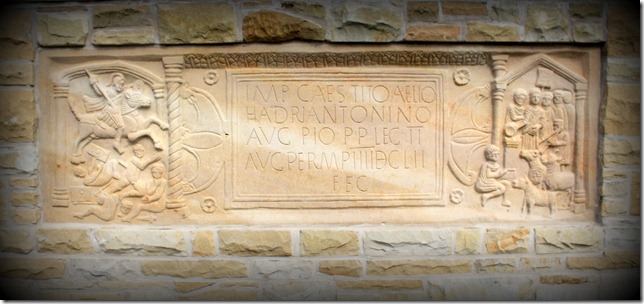The Bridgeness Distance Slab is one of the finest artefacts found along the Antonine Wall, the Empire’s Scottish frontier.
For decades the intricately decorated sandstone tablet – nine foot wide – has been on show in Edinburgh.
But now a new replica has been unveiled close to where the slab was found at Bridgeness in Bo’ness – to the delight of local people.
Community leaders hope the £70,000 installation will make residents more aware of their Roman roots and encourage them to explore the line of the Antonine Wall, Scotland’s fifth World Heritage Site.
> Visit the new replica – opposite Bridgeness Miners’ Welfare at Harbour Road, Bo’ness. Use the postcode EH51 9LF
The turf wall, built around 142 AD, ran from Bo’ness on the Forth to Old Kilpatrick on the Clyde. It gained UNESCO World Heritage Site status in 2008.
“Whilst the Romans used fairly basic implements to carve out the original Bridgeness Slab, the replica has been created using the latest hi-tech tools,” said Councillor Adrian Mahoney of Falkirk Council.
“The original slab was scanned using lasers and then a new slab cut in sandstone using computer-controlled milling equipment. The final piece was hand-finished by craftsmen.
“The final result is an extremely accurate copy of the Bridgeness Slab – revealing details not easily seen on the Roman original.
“We think people will be impressed – and this will attract them to sites along the Antonine Wall.”

The slab has a central panel in Latin, marking the completion of part of the Wall and honouring the Emperor Antoninus Pius. It also features a Roman calvaryman attacking local tribes – and Romans (in togas) getting ready to make a sacrifice to the gods.
Falkirk Council worked with Bo’ness Community Council to create the copy, now installed in a purpose-built wall and display area just off Harbour Road in Bo’ness. The site also includes information panels about the Antonine Wall and the surrounding area.
Madelene Hunt, the chair of the Community Council, said the Slab project had been a real labour of love.
“When the original slab was found in Bo’ness in the 1860s, it was quickly given to a museum in Edinburgh,” she said. “It’s now on show in the National Museum of Scotland in Chambers Street.
“For some people in the town, it’s a bit like the Elgin Marbles. We would love to have the original Roman slab back. Sadly, that won’t be happening. Therefore an exact replica is the next best thing. And this is a wonderful piece to look at.
“It’s been fascinating to see the new slab created, especially using all the hi-tech scanning and cutting equipment. But it’s even better to see it in place in Bo’ness and on view to the general public.”
Councillor Mahoney, the convener of leisure, tourism and community at the Council – and a local councillor in Bo’ness – said the Slab project had taken around 10 years to complete.
“There were false starts and delays, but the community were determined to put the Slab on show in the town where it was discovered,” he said.
“The people in the National Museum have been brilliant in helping us make a faithful copy – as have all our suppliers and the experts at Historic Scotland and Falkirk Community Trust.”
Funding for the replica came from the Council itself and Avondale Environmental Limited through Falkirk Environment Trust.
A film of the whole project, from laser scanning in the museum to installation of the slab in Bridgeness, has been made by local production company Sanctus Media. The documentary – “The Mark of Rome” – will premiere this October in the Hippodrome Cinema in Bo’ness. (It’s also viewable, in full, on YouTube).
Councillor Mahoney added: “This is the first major project to be completed along the Antonine Wall since it became a World Heritage Site in 2008. Hopefully it will kick-start further investment– and interest – in the site, and in the Roman history of Scotland.”
ABOUT THE NEW BRIDGENESS SLAB

The following companies have been involved in creating the replica Bridgeness Slab.
- Design consultants – The Paul Hogarth Company
- Cost consultants – David Campbell Associates
- Laser Scanning – CDDV
- Contractor – Rainton Construction Ltd
- Stone Supplier – Tennant’s (Elgin) Ltd
- Stone milling – Tradstocks Ltd
- Film Production – Sanctus Media Ltd
- Funders – Falkirk Council and Avondale Environmental Ltd – through Falkirk Environment Trust.
You can also find out more about the Slab – and the Romans in Scotland – at:
ABOUT THE ANTONINE WALL
The Antonine Wall was built around 142 AD on the orders Emperor Antoninus Pius (reigned 138-161). It survived as the north-west frontier of the Roman empire for a generation before being abandoned in the 160s in favour of a return to Hadrian’s Wall. The Wall stretched for nearly 60 km (40 Roman miles) across the narrow waist of Scotland from Bo’ness on the River Forth to Old Kilpatrick on the River Clyde. It consisted of a turf rampart, perhaps three to four metres high, fronted by a great ditch.
Find out more at www.falkirk.gov.uk/antoninewall
and http://www.antoninewall.org/
You must be logged in to post a comment.